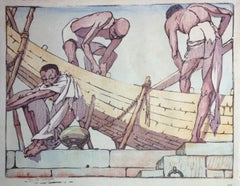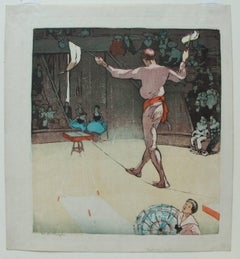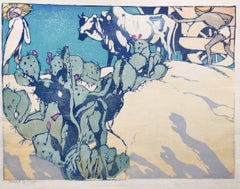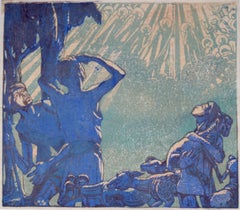Mabel Allington Royds Art
to
2
Overall Width
to
Overall Height
to
2
1
1
1
1
2
2
1
1
1
1
1
2
2
8,228
2,806
1,654
1,315
1
1
Artist: Mabel Allington Royds
Mabel A. Royds Boat Builders Woodblock print c. 1915-20
By Mabel Allington Royds
Located in London, GB
Mabel Alington Royds (1874-1941)
Boat Builders
Signed in pencil
c.1915-1920
Woodblock Print
23 x 30cm
Born in Bedfordshire, Mabel Royds was a painter, pr...
Category
Early 20th Century Art Deco Mabel Allington Royds Art
Materials
Woodcut
Tightrope Dancer
By Mabel Allington Royds
Located in New York, NY
ROYDS, Mabel Allington. Tightrope Dancer, ca 1911. Color woodcut. MB 1. From a small edition. Signed and titled in pencil.
After working with Walter Sickert in Paris at the turn ...
Category
1910s Realist Mabel Allington Royds Art
Materials
Woodcut
Related Items
Amoureux a Tarang, Yap, Ouest Carolines (Lovers of Tarang, Yap, West Carolines)
By Paul Jacoulet
Located in San Francisco, CA
This artwork titled "Amoureux a Tarang, Yap, Ouest Carolines 1935 is an original color woodcut by French artist Paul Jacoulet, 1896-1960. It is hand signed in pencil by the artist, ...
Category
Mid-20th Century Realist Mabel Allington Royds Art
Materials
Woodcut
$1,750
H 25.65 in W 21.5 in D 1.35 in
On the Beach : Bather in the Wind - Original wooodcut, Handsigned
Located in Paris, IDF
Jean Baptiste VETTINER (1871-1935)
On the Beach : Bather in the Wind, 1928
Original woodcut
Handsigned in pencil
Numbered /160
On vellum 32.5 x 25.5 cm (c. 13 x 10 in)
Bears the bli...
Category
1920s Art Deco Mabel Allington Royds Art
Materials
Woodcut
$300
H 12.8 in W 10.04 in
Blessed are the merciful / - The support of care -
Located in Berlin, DE
Nehmer, Rudolf (1912-1983), Blessed are the merciful, 1948
Rudolf Nehmer (1912 Bobersberg - 1983 Dresden), Blessed are the merciful, 1948. Woodcut on yellowish wove paper, 18.8 cm x ...
Category
1940s Realist Mabel Allington Royds Art
Materials
Woodcut
$228
H 16.93 in W 11.82 in D 0.4 in
Kumasaka Chōhan to Ushiwakamaru - One of a Diptych Original Woodcut Print
By Utagawa Kunisada (Toyokuni III)
Located in Soquel, CA
Kumasaka Chōhan to Ushiwakamaru is a Japanese Ukiyo-e print created between 1848 and 1854 by artist Utagawa Kunisada (Japanese, 1786-1864). The print is a Diptych, and is part of the...
Category
1850s Realist Mabel Allington Royds Art
Materials
Printer's Ink, Rice Paper, Woodcut
$880 Sale Price
20% Off
H 18.5 in W 13.68 in D 0.38 in
Vent du Nord, Coree
By Paul Jacoulet
Located in San Francisco, CA
This artwork titled "Vent du Nord, Coree" 1953 is an original color woodcut by French artist Paul Jacoulet, 1896-1960. It is hand signed in pencil by the artis...
Category
Mid-20th Century Realist Mabel Allington Royds Art
Materials
Woodcut
Ichimura Uzaemon XIII - actor as Okaji of Gion, 1862 "The Six Poetry Immortals"
By Utagawa Kunisada (Toyokuni III)
Located in Soquel, CA
Ichimura Uzaemon XIII - actor as Okaji of Gion, 1862 "The Six Poetry Immortals"
A Japanese Ukiyo-e woodcut print created circa 1862 by artist Utagawa Kunisada (Japanese, 1786-1864). ...
Category
1850s Realist Mabel Allington Royds Art
Materials
Printer's Ink, Rice Paper, Woodcut
$680 Sale Price
20% Off
H 21.75 in W 16.75 in D 1.25 in
Art Deco : The Mirror - Original wooodcut, Handsigned and Numbered
Located in Paris, IDF
Emile BOIZOT
Art Deco : The Mirror, 1927
Original woodcut
Handsigned in pencil
Numbered /160
On vellum 32.5 x 25.5 cm (c. 13 x 10 in)
Bears the blind stamp of the editor 'Imagier de...
Category
1920s Art Deco Mabel Allington Royds Art
Materials
Woodcut
$361
H 12.8 in W 10.04 in
'Dancers' — 1930s American Modernism
By Charles Turzak
Located in Myrtle Beach, SC
Charles Turzak, 'Dancers', 1939, wood engraving, edition 100. Signed, titled, and numbered 72/100 in pencil. A fine, richly-inked impression, on off-white Japan paper, with full marg...
Category
Mid-20th Century Art Deco Mabel Allington Royds Art
Materials
Woodcut
The Ayase River and Kanegafuchi, Summer, One Hundred Famous Views of Edo
By Utagawa Hiroshige (Ando Hiroshige)
Located in Soquel, CA
The Ayase River and Kanegafuchi, Summer, One Hundred Famous Views of Edo
Summer on the Ayase River by Hiroshige (Ando) Utagawa (Japan, 1797 - 1858 ). Woodcut circa 1856.
Ima...
Category
1850s Realist Mabel Allington Royds Art
Materials
Ink, Woodcut
$1,080 Sale Price
20% Off
H 19.5 in W 14.13 in D 0.38 in
1945 Brazilian Master, Art Deco Nudes Serigraph Woodcut Carnaval Bahia
By Odetto Guersoni
Located in Surfside, FL
Genre: Brazilian Art Deco, African Diaspora
Bahian Carnival
Subject: Abstract
Medium: Print
Surface: Paper
Country: Brazil
Dimensions of overall paper are listed.
This is from a series of work he did in the 1940's, we sold one called Ritmo Negro, they are about Afro-Brazilian jazz, dance and music.
Odetto Guersoni was born in the city of Jaboticabal, State of São Paulo, in 1924. From 1936 to 1941 he attended the Liceu de Artes de Ofícios in São Paulo, beginning his artistic career in 1945, when he exhibited paintings in the Hall of the Plastic Artists Union . Two years later he was part of the collective group of 19, alongside Aldemir, Charoux, Otavio Araújo, Grassmann, Maria Leontina and several other artists that time would make famous. He then practiced a figurative painting of accentuated Expressionist lauds, characterized by deformation and coloring, raw and Satirical- as, moreover, so many of his fellow exhibitors at the time. As a French government scholar, Odette Guerzoni went to Paris in 1947 and the following year took part in the Peintres et Graveurs Etrangers and Art Libre exhibitions. Student of engraving by Renê Cottet, gradually transformed this expressive medium into his favorite, to the detriment of painting, which he practically abandoned soon after.
In 1947, he participated in the 19 Painters exhibition at the Prestes Maia Gallery together with Lothar Charoux, Maria Leontina,Grassmann, Aldemir Martins, Luiz Sacilotto and hiró. Guersoni was awarded a scholarship by the French government, and traveled to Paris, where he began work in engraving. Back in Brazil, in 1951, he founded the Art Workshop, in São Paulo. In 1954, he returned to Europe for a year, financed by the International Labor Organization (ILO). In Geneva, he studied engraving with René Cottet (1902 - 1992) and worked in Stanley william Hayter's studio, Atelier 17, in Paris (1901 - 1988). From 1956 to 1957, he became director of the Union of Plastic Artists of São Paulo. From 1960, he attended, as a trainee, some art schools in the United States and Japan such as The New York School of Printing and Osaka University. In 1971, also in Japan, he attended the workshop of I. Jokuriti. Two years later, he was voted Best Recorder of the Year by the Paulista Association of Art Critics - APCA. He took part in a special room at the Ibero-American Biennial in Montevideo in 1983. The Pinacoteca do Estado de São Paulo - Pesp presents a retrospective of his work in 1994.
Odetto Guersoni explores the wide spectrum of possibilities of the engraving. In addition to using techniques such as metal etching, lithograph, serigraph, linocut and, especially, woodcut he developed, in the 1950s, the philigraphy, in which the forms he developed gained points of embroidery made by Bonadei (1906 - 1974) . And, in the 1960s, the plastigraphy, in which he makes engravings on pasty surfaces, obtained from gypsum or other soft material. In the 1970s, technical investigations were associated with pictographic, ideographic, archaic symbol searches, Brazilian cave paintings and plant forms. The drawings are reduced to stylized, geometric shapes and transformed into abstract graphic elements. The artist works with few matrices, which, organized in rectangles, squares or circles, become modules to be combined. Guersoni juxtaposes them, adds, changes colors, and thereby composes colorful mandalas and structural geometries. Based on concise compositions, it produces color vibrations through optical illusions. In many of his woodcut works of the 1980s he uses smooth wood, knives, saws, gouges, punches, avoiding the natural textures of wood. In printing, it leaves the vibrant color and employs dosed inks with colorless masses, obtaining transparencies by superpositions. New journeys of study and specialization in engraving techniques took him in 1954 to Switzerland, 1960 to the United States, and in 1966 to Germany and Austria. Today, after having performed more than 40 individuals including 16 abroad and having participated in more than 50 collectives in several countries, Guersoni is considered one of the most notable Brazilian engravers. Conquered awards in several shows.
CHRONOLOGY
Individual exhibitions
1946 - Sao Paulo SP - 10th Salon of the Artists' Union, at the Prestes Maia Gallery
1947 - São Paulo SP - 19 Painters, at the Prestes Maia Gallery
1948 - Paris France - Peintres et Graveurs Etrangers at the École des Beaux-Arts
1949 - São Paulo SP - 13th Salon of the Artists' Union, at the Prestes Maia Gallery
1951 - São Paulo SP - 1st Paulista Salon of Modern Art, at Prestes Maia Gallery - silver medal
1953 - São Paulo SP - 2nd International Biennial of São Paulo, at MAM / SP
1954 - São Paulo SP - 3rd Paulista Salon of Modern Art, in the Prestes Maia Gallery
1955 - Rio de Janeiro RJ - 4th National Salon of Modern Art
1955 - Salvador BA - 5th Baiano Salon of Fine Arts, in Belvedere da Sé - honorable mention
1962 - São Paulo SP - Leirner Prize for Contemporary Art at the Folha Art Gallery - 1st printing award
1963 - Curitiba PR - 20th Salão Paranaense de Belas Artes, at the Public Library of Paraná
1963 - Rio de Janeiro RJ - Individual, no MAM / RJ
1968 - Bradford England - First International Print Biennale
1970 - São Paulo SP - Antonio Henrique Amaral, Odetto Guersoni, Tomie Ohtake, Pedro Tort and Gerda Brentani, in the Alberto Bonfiglioli Gallery
1971 - São Paulo SP - 11th International Biennial of São Paulo, at the Biennial Foundation - acquisition award
1973 - Punta del Este Uruguay - 1st Engraving Meeting of the Prata Basin Countries - International Prize
1977 - São Paulo SP - The Groups: the 40's, at the Lasar Segall Museum
1982 - São Paulo SP - Ismenia Coaracy, Odetto Guersoni and Alice Brill...
Category
1940s Art Deco Mabel Allington Royds Art
Materials
Woodcut
$600
H 8.5 in W 12 in D 0.1 in
Antique Map of The City of Rome by Sebastian Münster, 1549
By Sebastian Münster
Located in New York, NY
Sebastian Münster (German, 1488-1552)
LA SITUATION DE LA VILLE DE ROME
Antique Map of Rome, 1549
Possibly printed in 1964
Print on paper
Publisher:...
Category
1960s Realist Mabel Allington Royds Art
Materials
Woodcut
$1,200
H 15.875 in W 19.75 in D 0.6 in
The Zero Hour / - After the End of the World -
Located in Berlin, DE
Rudolf Nehmer (1912 Bobersberg - 1983 Dresden), The Zero Hour, 1948. Woodcut on yellowish wove paper, 20 cm x 14.8 cm (image), 43 cm x 30 cm (sheet size), signed “Rud.[olf] Nehmer” i...
Category
1940s Realist Mabel Allington Royds Art
Materials
Woodcut
Previously Available Items
Mabel A. Royds Prickly Pear Woodblock print English 1930s Edwardian
By Mabel Allington Royds
Located in London, GB
To find more of these unusual woodblock prints by Royds scroll down to "More from this Seller" and below it click on "See all from this Seller."
Mabel Alington Royds (1874-1941)
Prickly Pears
Signed in pencil
c.1915-1920 (exhibited 1928)
Woodblock Print
22 x 29cm
Born in Bedfordshire, Mabel Royds was a painter, printmaker and illustrator. She studied under Henry Tonks at the Slade, after which she travelled to Paris - where she worked in the studio of Walter Sickert - and to Canada, before starting to teach at the Edinburgh College of Art in 1911. In 1914 she married the printmaker Ernest Lumsden...
Category
1910s Art Deco Mabel Allington Royds Art
Materials
Woodcut
Mabel A. Royds The Shepherds Woodblock print c.1920
By Mabel Allington Royds
Located in London, GB
To find more of these unusual woodblock prints by Royds scroll down to "More from this Seller" and below it click on "See all from this Seller."
Mabel A. Royds (1874-1941)
Colour woodblock print
Signed in pencil
Exhibited 1942
29 x 33cm (approx.)
Born in Bedfordshire, Mabel Royds was a painter, printmaker and illustrator. She studied under Henry Tonks at the Slade, after which she travelled to Paris - where she worked in the studio of Walter Sickert - and to Canada, before starting to teach at the Edinburgh College of Art in 1911. In 1914 she married the printmaker Ernest Lumsden...
Category
Early 20th Century Art Deco Mabel Allington Royds Art
Materials
Woodcut
Mabel A. Royds The Snake Charmer Woodblock print c.1920
By Mabel Allington Royds
Located in London, GB
Mabel A. Royds (1874-1941)
The Snake Charmer
Colour woodblock print
Signed in pencil
c.1920s
13.5 x 18cm (approx.)
Born in Bedfordshire, Mabel Royds was a painter, printmaker and illustrator. She studied under Henry Tonks at the Slade, after which she travelled to Paris - where she worked in the studio of Walter Sickert - and to Canada, before starting to teach at the Edinburgh College of Art in 1911. In 1914 she married the printmaker Ernest Lumsden...
Category
1910s Art Deco Mabel Allington Royds Art
Materials
Woodcut
Mabel A. Royds The Flight in Egypt Woodblock print c. 1920
By Mabel Allington Royds
Located in London, GB
Mabel A. Royds (1874-1941)
The Flight into Egypt
Colour woodblock print
Signed in pencil
Exhibited 1942
29 x 33cm (approx.)
Born in Bedfordshire, Mabel Royds was a painter, printmaker and illustrator. She studied under Henry Tonks at the Slade, after which she travelled to Paris - where she worked in the studio of Walter Sickert - and to Canada, before starting to teach at the Edinburgh College of Art in 1911. In 1914 she married the printmaker Ernest Lumsden...
Category
Early 20th Century Art Deco Mabel Allington Royds Art
Materials
Woodcut
ANGELS APPEARING TO THE SHEPARDS - Gift for Christmas
By Mabel Allington Royds
Located in Santa Monica, CA
MABEL ROYDS (1874 - 1941)
ANGELS APPEARING TO THE SHEPARDS c. 1920
Color woodcut, signed in pencil 11 1/4 x 14.
England, Arts and Crafts,
Category
1920s Modern Mabel Allington Royds Art
Materials
Woodcut
Mabel Allington Royds art for sale on 1stDibs.
Find a wide variety of authentic Mabel Allington Royds art available for sale on 1stDibs. You can also browse by medium to find art by Mabel Allington Royds in woodcut print and more. Much of the original work by this artist or collective was created during the 20th century and is mostly associated with the Art Deco style. Not every interior allows for large Mabel Allington Royds art, so small editions measuring 8 inches across are available. Customers who are interested in this artist might also find the work of Alexandre Iacovleff, Leonardo Brunelleschi, and John Hassall. Mabel Allington Royds art prices can differ depending upon medium, time period and other attributes. On 1stDibs, the price for these items starts at $471 and tops out at $3,000, while the average work can sell for $471.



